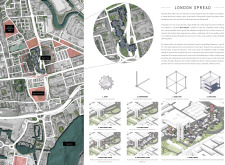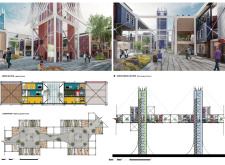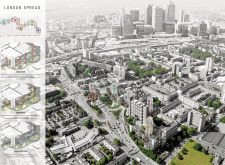5 key facts about this project
The architectural layout features a well-defined arrangement of residential, commercial, and communal spaces. Key components of the plan include strategically positioned shared areas, green spaces, and multifaceted housing types. By integrating these elements, the project ensures an interconnected lifestyle that encourages social interaction and a sense of community among its inhabitants. This balance between living, working, and recreational spaces establishes an environment where residents can engage meaningfully with both their neighborhood and each other.
Particular attention has been paid to the building's structure and materials, reinforcing the project's commitment to sustainability and resilience. Steel frameworks provide strength and enable modular configurations, while expansive glass facades invite natural light and connect indoor spaces with the surrounding environment. The choice of brick adds a layer of warmth to the exterior, contributing to the aesthetic of the neighborhood and reducing the scale of the buildings in relation to their urban context. Additionally, the use of wood in communal areas enhances the warmth of shared spaces, making them inviting and comfortable.
An unique approach implemented in this design is the focus on creating open plazas and promenades, which serve as public gathering places. These spaces not only foster community spirit but also enable diverse cultural and commercial activities, integrating daily life with social engagement and local commerce. The introduction of parks and green roofs throughout the design highlights the importance of accessible natural elements within urban settings. This serves to enhance well-being, offering serene spots for relaxation amidst the urban hustle.
In terms of functionality, the project includes a range of housing typologies that cater to different demographics. From compact studio apartments aimed at young professionals to larger family units and shared living arrangements, the architecture accommodates various living preferences. Each residence is designed with an emphasis on comfort and efficiency, encouraging a higher quality of life while minimizing environmental impact.
Sustainability is deeply embedded in the design principles, with features such as solar panels and rainwater collection systems prioritized for energy efficiency. These elements not only reduce the carbon footprint of the project but also promote responsible consumption within the community. By blending innovative environmental practices with urban architecture, the design contributes positively to the city's ecological landscape.
Overall, this architectural project is a compelling example of how contemporary design can address urban challenges and enhance community living. The emphasis on modularity, sustainability, and social engagement sets this project apart within the architectural landscape of London. By exploring the architectural plans, sections, designs, and ideas presented, readers can gain a comprehensive understanding of the thoughtful considerations that underpin this urban development initiative. Engaging with the project's detailed presentation will offer deeper insights into its unique contributions to modern architecture and urban living.


























